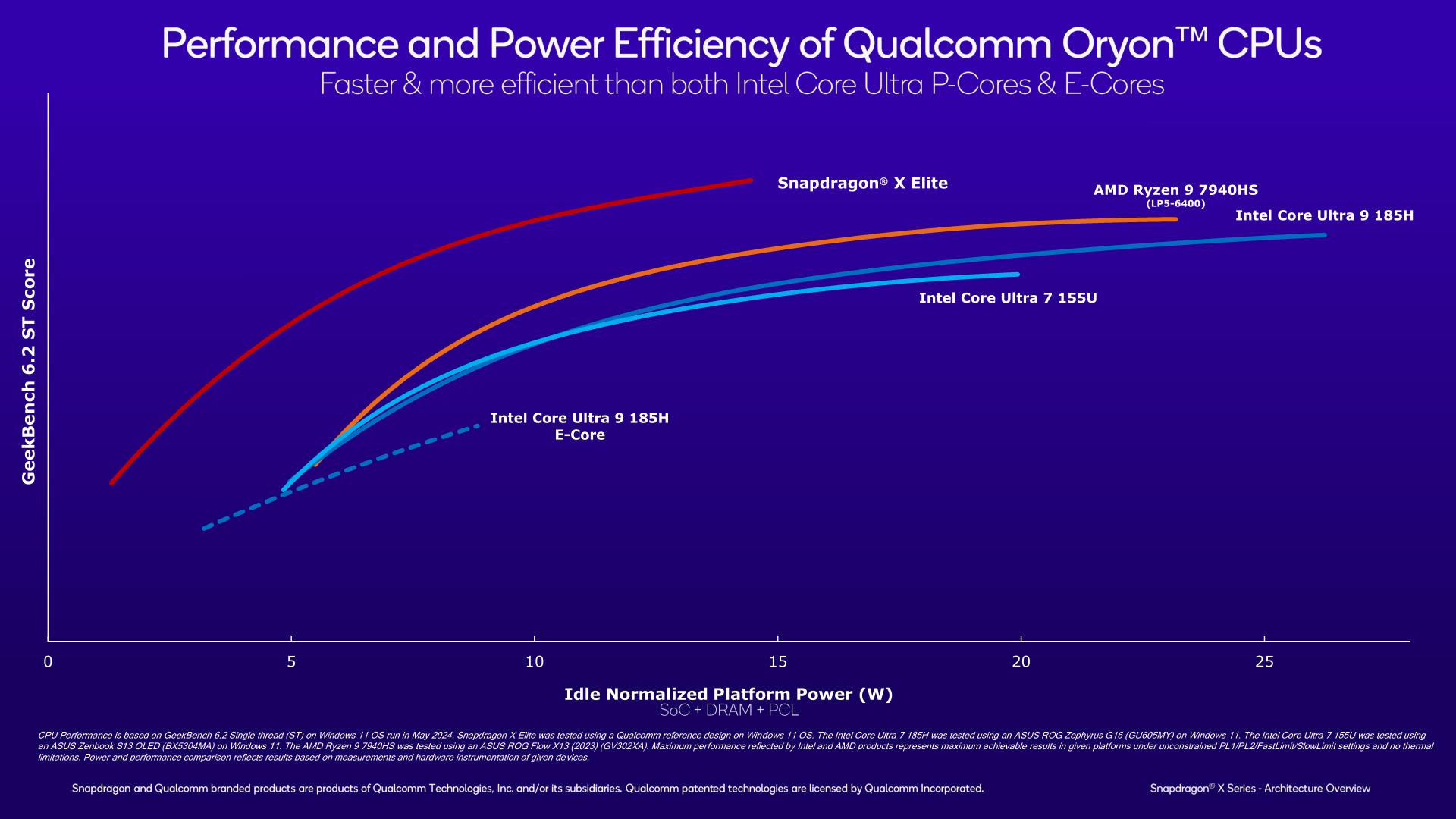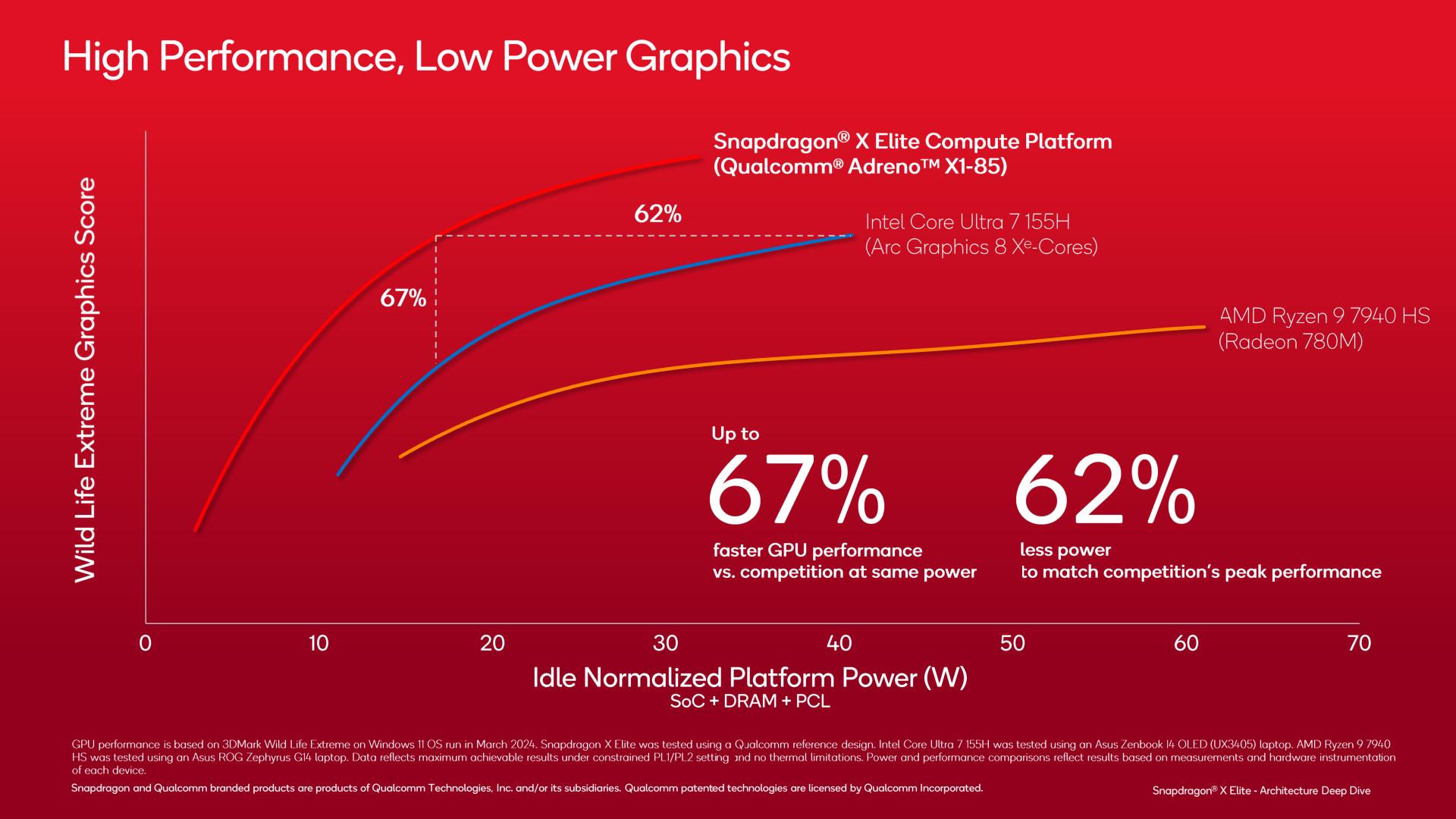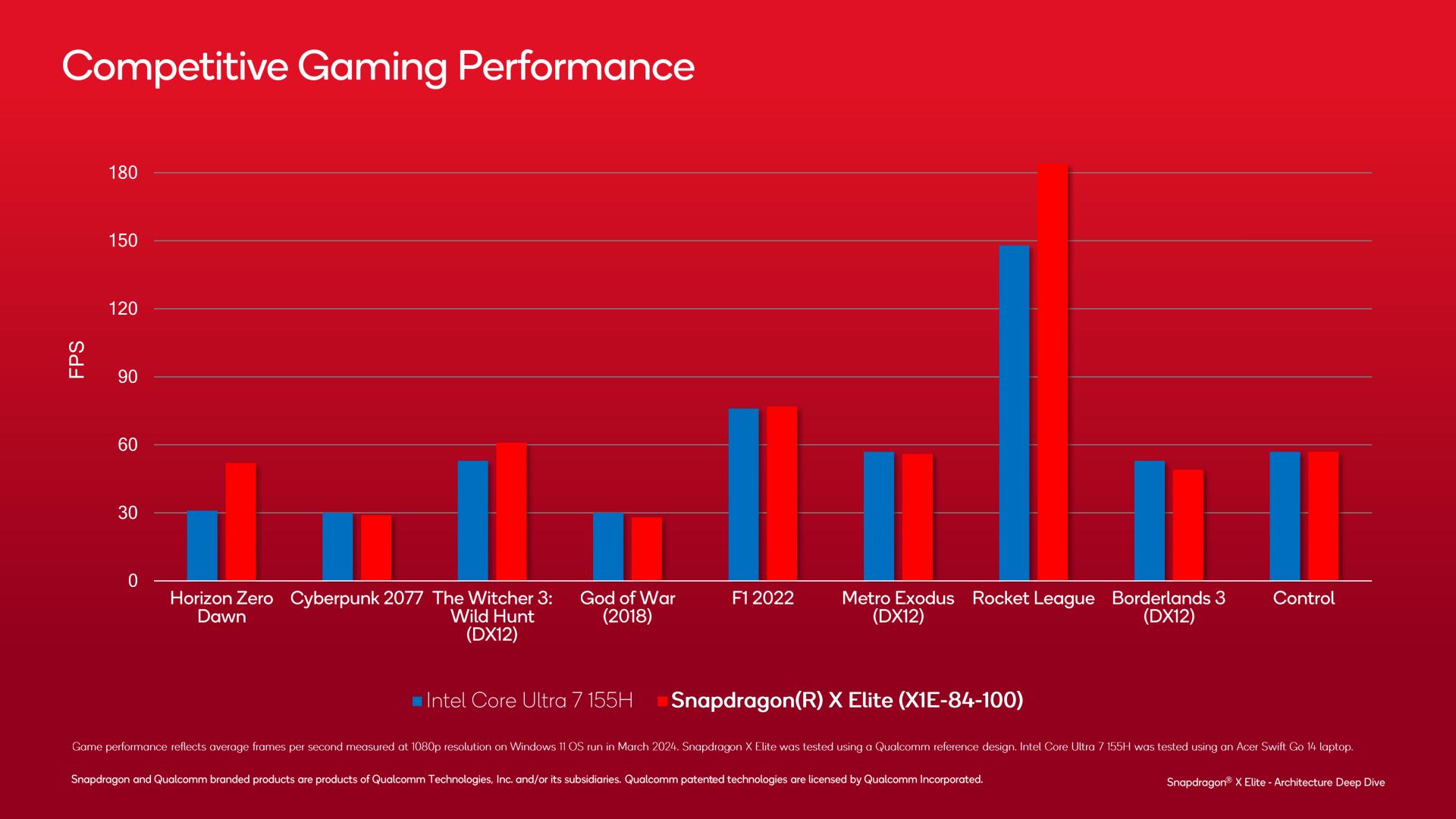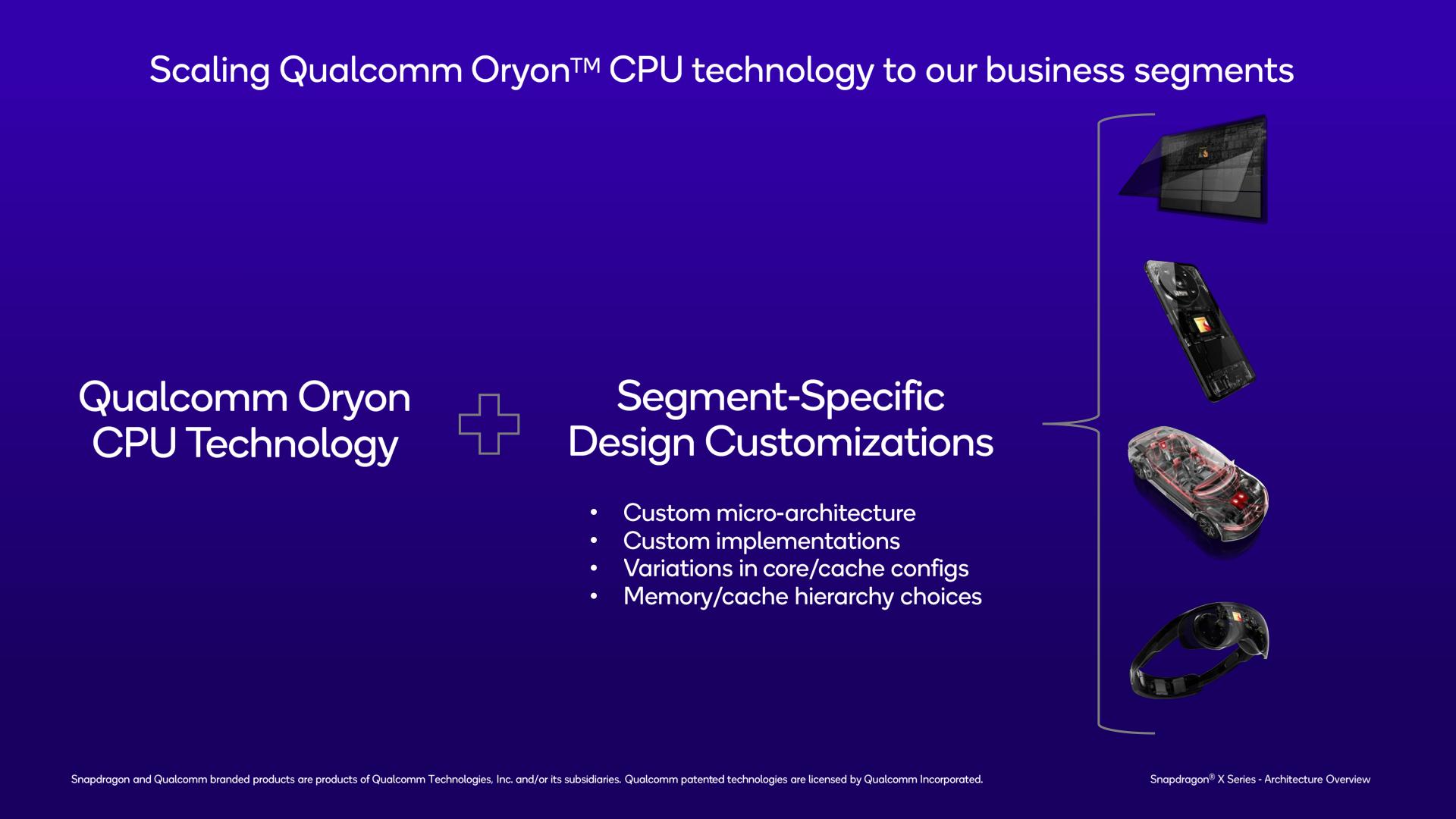The Qualcomm Snapdragon X Architecture Deep Dive: Getting To Know Oryon and Adreno X1
by Ryan Smith on June 13, 2024 9:00 AM ESTPerformance Promises and First Thoughts
Wrapping things up, let’s touch upon a couple of Qualcomm’s performance slides before closing out this architectural deep dive. While the whole world will get to see what the Snapdragon X can do first-hand next week when retail devices launch, until then it gives us a bit more insight into what to expect. Just be sure to take it with the requisite grain of salt.
On the CPU side of matters, Qualcomm is claiming that the Snapdragon X Elite can beat the entire field of contemporary PC competitors in GeekBench 6.2 single-threading. And by a significant degree, too, when power efficiency is taken into account.
In short, Qualcomm claims that the Oryon CPU core in the Snapdragon X Elite can beat both Redwood Cove (Meteor Lake) and Zen 4 (Phoenix) in absolute performance, even if the x86 cores are allowed unrestricted TDPs. With mobile x86 chips turboing as high as 5GHz it’s a bold claim, but not out of the realm of possibility.
Meanwhile on the GPU front, Qualcomm is making similar energy efficiency gains. Though the workload in question – 3DMark WildLife Extreme – is not likely to translate into most games, as this is a mobile-focused benchmark that has long been optimized to heck and back within every mobile SoC vendor’s drivers.
Performance benchmarks using actual games are arguably more useful here. And even though Qualcomm is probably doing some cherry-picking, the top Snapdragon X SKU is often trading blows with Intel’s Core Ultra 7 155H. It admittedly makes for a less impressive showing overall, but it’s good to see where Qualcomm is currently landing on real games. And in this case, even just a mix of ties/beats of one of Intel’s better mobile chips is not a bad showing.
First Thoughts
And there you have it, our first deep dive into a Qualcomm Snapdragon X SoC architecture. With Qualcomm investing into the Windows-on-Arm ecosystem for the long haul, this will hopefully be the first of many, as the company seeks to become the third major Windows CPU/SoC vendor.
But the ultimate significance of the Snapdragon X SoC and its Oryon CPU cores goes beyond just mere SoCs for PC laptops. Even if Qualcomm is wildly successful here, the number of PC chips they’ll ship will be a drop in the bucket compared to their true power base: the Android SoC space. And this is where Oryon is going to be lighting the way to some significant changes for Qualcomm’s mobile SoCs.
As noted by Qualcomm since the start of their Oryon journey, this is ultimately the CPU core that will be at the heart of all of Qualcomm’s products. What starts this month with PC SoCs will eventually grow to include mobile SoCs like the Snapdragon 8 series, and farther along still will be Qualcomm’s automotive products, and high-end offshoots like their XR headset SoCs. And while I doubt we’ll really see Oryon and its successors in Qualcomm’s product in a true top-to-bottom fashion (the company needs small and cheap CPU cores for their budget lines like Snapdragon 6 and Snapdragon 4), there is no doubt that it’s going to become a cornerstone of most of their products over the long run. That’s the value of differentiation of making your own CPU core – and getting the most value out of that CPU core by using it in as many places as possible.
Ultimately, Qualcomm has spent the last 8 months hyping up their next-generation PC SoC and its bespoke CPU core, and now it’s time for all of the pieces to fall into place. The prospect of having a third competitor in the PC CPU space – and an Arm-baesd one at that – is exciting, but slideware and advertising aren’t hardware and benchmarks. So we’re eagerly awaiting what next week will bring, and seeing if Qualcomm’s engineering prowess can live up to the company’s grand ambitions.




















52 Comments
View All Comments
AntonErtl - Friday, June 14, 2024 - link
Spectre is not at all an inherent consequence of speculative execution.Speculative execution does not reveal information through architectural state (registers, memory), because CPU designers have been careful to reset the architectural state when detecting a branch misprediction. They have not done this for microarchitectural state, because microarchitecture is not architecturally visible. But microarchitectural state can be revealed through side channels, and that's Spectre.
So the first part of the Spectre fix is to treat microarchitectural state (e.g., loaded cache lines) like architectural state: Buffer it in some place that's abandoned when the speculation turns out to be wrong, or is promoted to longer-term microarchitectural state (e.g., a cache) when the instruction commits (look for papers about "invisible speculation" to see some ideas in that direction). There are also a few other side channels that can reveal information about speculative processed data that need to be closed, but it's all doable without excessive slowdowns.
Intel and AMD have been informed of Spectre 7 years ago. If they had started working on fixes at the time, they would have been done long ago. But apparently Intel and AMD decided that they don't want to invest in that, and instead promote software mitigations, which either have an extreme performance cost, or require extreme development efforts (and there is still the possibility that the developer missed one of the ways in which Spectre can be exploited), so most software does not go there. Apparently they think that their customers don't value Spectre-immunity, and of course they love the myth that Spectre is inherent in speculation, because that means that few customers will ask them why they still have not fixed Spectre.
It's great that the Oryon team attacks the problem. I hope that they produced a proper fix; the term "mitigation" does not sound proper to me, but I'll have to learn more about what they did before I judge it. I hope there will be more information about that forthcoming. Reply
skavi - Friday, June 14, 2024 - link
great article. it’s nice to see quality stuff like this. Replynandnandnand - Friday, June 14, 2024 - link
"Officially, Qualcomm isn’t assigning any TDP ratings to these chip SKUs, as, in principle, any given SKU can be used across the entire spectrum of power levels."A Qualcope since they are differentiating the SKUs by max turbo clocks. Reply
eastcoast_pete - Friday, June 14, 2024 - link
First, thanks Ryan! Glad to see you doing deep dives again.Questions: 1. Anything known about if and how well the Snapdragon Extreme would pair up with a dGPU? The iGPU's performance is (apparently) in the same ballpark as the 780M and the ARC in Meteor Lake, but gaming or workstation use would require a dGPU like a 4080 mobile Ada or the pro variant. So, any word from Qualcomm on playing nice with dGPUs?
2. The elephant in the room on the ARM side is the unresolved legal dispute between Qualcomm and ARM over whether Qualcomm has the right to use the cores developed (under an ALA) by Nuvia for the development of ARM-based cores for server CPUs in (now) client SoCs. Any news on that? Some writers have speculated that this uncertainty is one, maybe the key reason for Microsoft to also encourage Nvidia and MediaTek to develop client SoCs based on stock ARM architecture. MS might hedge its bets here, so they don't put all the work (and PR) into developing Windows-on ARM and "AI" everywhere and find themselves with no ARM Laptops available to customers if ARM prevails in court. Reply
Ryan Smith - Friday, June 14, 2024 - link
1) That question isn't really being entertained right now since the required software does not exist. If and when NVIDIA has a ARMv8 Windows driver set, then maybe we can get some answers.2) The Arm vs. Qualcomm legal dispute is ongoing. The court case itself doesn't start until late this year. In the meantime, any negotiations between QC and Arm would be taking place in private. There's not really much to say until that case either reaches its conclusion - at which point Arm could ask for various forms of injunctive relief - or the two companies come to an out-of-court settlement. Reply
eastcoast_pete - Saturday, June 15, 2024 - link
Thanks Ryan! Looking forward to the first tests. Replycontinuum - Saturday, June 15, 2024 - link
Great article, can't wait til actual reviews next week. Thanks Ryan! ReplyMooseMuffin - Saturday, June 15, 2024 - link
When should we expect to see Oryon cores in android phones? ReplyRyan Smith - Sunday, June 16, 2024 - link
Snapdragon 8 Gen 4 late this year. Replyabufrejoval - Thursday, June 20, 2024 - link
So the embargos have lifted......and the silence is deafening?
Is this Microsoft's Vision Pro moment? Reply